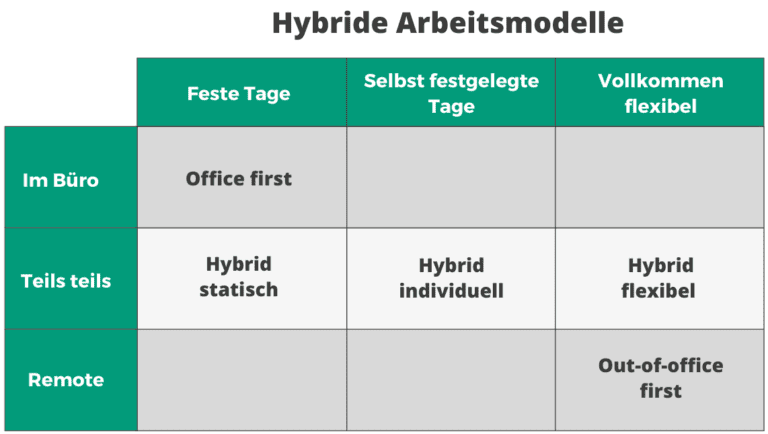The shift to a hybrid working model
Published

After a year of changes to working conditions, it's worth thinking about how traditional businesses might change post-pandemic. CEOs and teams around the world have experienced firsthand some of the benefits that remote work can offer. However, it seems naive to imagine that companies forced to work remotely will choose to do so entirely.
There is a traditional appeal for employers to stick with an office environment. It's easier to monitor what's going on, meetings can be held face-to-face, and old habits die hard. Employees, on the other hand, value more freedom in their work. Modern technology has become so advanced that employees feel like they can do their jobs anywhere. As you can see, it is difficult to reconcile the expectations of both sides.
We're more likely to see a mix of old and new as an answer to this question. Instead of extremes, a smoother transition can be created, tailored to each company's unique situation. Here comes this hybrid model into play, which is a topic worth exploring for anyone who wants to maintain some aspects of remote work.
What is a hybrid working model?
A hybrid model is simply a mix of remote work and office work in the same location. It combines certain aspects of telecommuting with some of the traditional aspects we expect from an office. But there isn't just one type Hybrid working model . Here are some of the most common forms:
- One central office with hot desking for workers who are in the office
- One central office and full-time remote workers
- One central office mandating people to spend a particular number of days in the office
- Multiple offices and hot desking
- Multiple offices and remote workers
- Multiple offices mandating people to spend a particular number of days in the office
There are also differences in the approaches to the work processes. A company has the choice to work more with remote methods than office-based methods or vice versa. This is especially important when it comes to communication and collaboration.
The time that employees spend in the office is also up for grabs. It may be that everyone has a choice of when to come to the office or that a certain number of days is required. It is also not uncommon to have teams that work in the office, but also those that work completely remotely and perhaps even spread across the globe.
What will happen to the office?
A hybrid work model still has a physical office space for those who want to use it or for teams that work in the office permanently. Those working remotely may come in from time to time or not at all, depending on the location and needs of the company. In this model, all standard office processes must be made accessible to remote employees in some form. This could include conference calls for meetings or a budget for travel to the office if necessary. Remote employees should be given equal opportunities to collaborate and participate in office life.
Teams that work primarily remotely may even occasionally spend a few days in the office. There are many different variants of the model, which we will discuss later. Given the changes in working conditions we have seen over the last year, a hybrid model seems to be a good option for many companies post-pandemic. Many people who have experienced the benefits of telecommuting now want to retain a certain degree of freedom.
What are the different types of hybrid work models?

Those: sharednc.com
A hybrid remote work model seems self-explanatory, but there are a variety of ways to use it. From the list and examples above, it appears that there is a combination that will essentially meet all of your needs.
The type of hybrid work model you use depends on the nature of your work and the approach of your teams. The current situation of your company can also affect the type of hybrid model. If you already have some remote working practices in place, you are much more likely to move further towards a distributed structure.
Remote-first versus Office-first
A significant difference hybrid working models is the way a company handles the work of its employees. There is usually a connection between employees' freedom to work remotely and the approach chosen. Hybrid companies can take an “office-first” approach that is more closely aligned with the processes that would occur in a regular office.
Some teams may be in the office all the time, while remote employees drop in occasionally for meetings or tasks. Each employee could be allowed a certain degree of flexibility in when they come and go. In all of this, the focus is on traditional office activities. The strengths of the office and the proximity to colleagues are highlighted.

Those: recruitment-software.co.uk
A hybrid remote work model is the opposite path one can take. This method favors collaboration and communication techniques found among remote workers and teams. In this case, asynchronous communication is the order of the day. Physical meetings are not necessary and only take place when everyone involved happens to be in the office.
Instead of replicating operations in an office, teams collaborate with the benefits of remote work. This includes long periods of concentration without distractions, known as “deep work,” and, above all, communication that does not require an immediate response.
Hybrid working models that evolve with your company
For some employees and teams, there is simply no choice but to work in an office. Physical access to work equipment is required, or perhaps customers and clients need to be attended to face to face. A hybrid working model is simply not possible here.
For companies that operate more knowledge-based, a hybrid work model is more likely to creep in over time rather than being chosen outright. In many branches, hybrid working arrangements were only introduced in response to the global pandemic. Policies and practices still attempt to replicate the office, and communication and habits are very office-oriented.
As time goes on, remote-first practices are becoming more common, and both employees and employers are realizing the benefits of remote work. You may have noticed this, as 74% of CFOs have said they plan to keep some employees permanently in the field even after the pandemic.
Your company may even hire global talent and employees who never come into the office or meet their teammates in person. Over time, the focus on telecommuting will increase rather than decrease. At the end of the scale, there could even be a transition to a fully remote company.
All of these models are ultimately a further development of the previous one. So time is also a key factor in the different types of remote hybrid models.
What are the advantages of each hybrid model?
If you want to explore how your business can operate in a hybrid model, you have many different options to choose from. Either combination will likely favor either remote workers or office workers. Finding a balance can be difficult, and you'll usually get better results if you choose one approach and implement it consistently.
The way you organize your setup depends on how much time you allow your employees to work remotely and even who is allowed to work remotely:
Complete freedom to choose between office and remote work
If you want to give your employees choice, you need to set some ground rules about what is allowed and what isn't. Will you allow your employees to travel while working? Will you hire international employees? How can you effectively manage your office space according to your employees' wishes? As you can see, there are several options that affect the pros and cons of the situation.
Advantages: With this model you can save significantly on office space. It is very likely that employees will choose to spend more time working remotely than in other configurations because it is desirable. This can also affect their work-life balance and even their productivity.

Those: mohammedshehu.com
If you find that most of your teams work outside of the office, you can also adopt remote-first practices. This means everyone can benefit from the advantages of intensive work and asynchronous communication. If you choose, you can add team members from all over the world to your team.
Cons: The natural social contacts you experience in an office will inevitably occur less. You may also find that some of your office activities need to be reduced. Team meetings will be held in person much less often, but that depends on how much value you place on them.
Although you will need less office space, it will be more difficult to determine your exact needs. Your operating costs per person may be slightly less efficient.
Some days in the office and some days on the road
A schedule that includes three days in the office and two days away, or vice versa, is also popular. This model tries to combine the best of both worlds, but can still focus on office work.
Pros: Not every company is willing to allow a lot of freedom when it comes to remote work. Employees may lack experience and managers may lack the ability to manage such a change. However, a few days out of the office has far less impact on the status quo.
Meetings, social contacts and spontaneous communication will continue to take place to some extent. If your industry or work depends on it, this is a definite advantage.
Cons: Some employees feel like they can do much of their work remotely and no longer have to come to the office on required days. On days when employees work remotely, they may have to follow office working hours, making their work more inefficient.
Additionally, you can only hire employees who can come to the office. This significantly limits the talent pool your company can work with.
Some permanent office workers and some permanent field workers
This model is another attempt to combine the benefits of remote workers and co-located employees. However, it has a number of advantages and disadvantages that differ from those of the previous model. In this case, the permanent remote employees may even be new employees of the company. Switching to a hybrid model can be an expansion plan and does not change the conditions for your existing employees.

Those: capital.de
Pros: The benefits of office work can be maintained for some teams and employees. At the same time, you can also hire employees who work completely remotely, perhaps even worldwide. If you wish, you can even distribute work across time zones on a relay basis.
Disadvantages: Working methods and practices can vary from team to team, which can lead to conflicts. Requiring office workers and remote workers to use the same approach puts one side at a significant disadvantage in their work.
Which approach is best for my company?
To answer this question, you need to consider a number of factors. This includes the type of work to be carried out, the skills and minds of your employees and even logistics.
Realistically, you have to choose between a model where work is done remotely and a model where work is done in the office. As we mentioned earlier, the strength of a hybrid model lies in its flexibility. Your model can and likely will change as you learn more about what works and what doesn't work.
What do my employees want?
Ultimately they are your Coworkers who have to cope with the measures introduced. While you may think a particular setup is a good idea, your colleagues often have a better idea of what actually works for them.
Technical teams may need access to specialized equipment that they cannot use at home. Some teams are finding that they can actually do most of their work from home. This question is truly one of the most important ones to ask, so make sure you answer it correctly!
How much of my team has experience working remotely?
If all employees are new to telecommuting or have little experience, this may impact the route you want to take. Moving most employees out of the office or giving them a lot of freedom to work from home may not be the best solution at first. Your team's level of remote training or experience will change over time, so you can still change your hybrid model over time.
Does my team need physical access to the tools they need to do their work?
Some industries rely on tools that cannot necessarily be relocated to a home office. In this case, a hybrid model with an office focus is likely necessary. A good example of machines that cannot be taken home are expensive computing devices needed for intensive modeling or high-quality printing. If these are used by employees on a daily basis, this must be taken into account.
Do we need an open office environment where ideas are exchanged?
If you work in an agency or in an environment where quick, spontaneous thinking is important, then it's best to set up the office in a mixed environment. Of course, there are tools that can facilitate these types of meetings in a remote environment. However, you will often find that the same situation cannot be replicated as well from home.

Those: de.nowystyl.com
Do I want to hire worldwide?
One of the main benefits of using remote workers is that you don't necessarily have to hire locally. You can hire workers from all over the world and tap into a global talent pool. If this is the case, your hybrid model needs to include considerations for these workers. If you have a large number of workers who don't have the option to come to the office, then remote-first is a much better fit for your business.
Introduction of a hybrid working model
Once you've decided what's best for you and your teams, you need to do some preparation for a successful implementation. The entire process will likely take some time as you learn, try, and see what works.
However, there are some important, basic points to keep in mind that can get you on your way:
Create a solid remote work policy
You've probably already established some basic rules for remote work. However, these are probably not enough and you will have to expand them. We primarily recommend that you seek outside help in creating these rules. This way you can avoid common pitfalls and traps and start working well remotely right away.
If you don't have the budget or time for it, there are a wealth of excellent resources online. Look for interviews, workshops, and articles from companies like Buffer, Doist, and GitHub. All three provide information and tips on how to best implement good remote work practices.
Once you've created your new remote work policy, distribute it to your teams and make it required reading. This will ensure everyone is familiar with your new processes and also give them the opportunity to take ownership.
Invest in technology and infrastructure
This is one of the most important points you need to pay attention to. Your teams will need to rely much more heavily on hardware and software to complete their workday. Laptops must be provided, as well as company-wide access to communication and collaboration tools. If you don't already have these tools, you may need to invest a significant amount to set up your hybrid remote model.
Consider your office space needs
Depending on how many people will be using your office, you may not need such a large space. If your employees are working remotely for a certain number of days, perhaps you can downsize the space and implement a "hot desk policy." This means that the same room is used by multiple employees, depending on who is currently in the office.
Redesign your meeting rooms for more personalized use
It's common knowledge that meetings where remote workers and other team members work in the same room are not optimal. It's much better if everyone is individually connected to a call. Your team members working in the same office will, whether they like it or not, dominate the conversation and collaboration.
Promote communication and create incentives
When some employees work at home and others work in the office, communication can stall. Remote workers can become more isolated and miss important conversations and meetings. Both environments need a free flow of communication to ensure everyone is on the same page. To achieve this, you should find communication tools that your employees will actually use by asking them what they would like to introduce.
Keep conversations flowing by incentivizing conversations. Development in the workplace can be directly related to being visible and letting others know what you are doing.
Actively support your culture
Some of the activities and culture building that occur naturally in an office now need to have an online element. While you can still hold social events in the office, you also need to incorporate remote aspects. Remote team building with a budget that allows employees to order food and drinks is always a hit.
If you offer benefits, consider making them more flexible for employees working from home. Subscriptions to digital services, online training courses, and gift cards are simple and easy-to-implement ideas. While they eat up some budget, they give back in a way that is invaluable to the company culture.
Assign someone responsible for remote work.
Appointing someone to address remote work policies, methods, and practices helps centralize decision-making and remove pressure from senior management. You could even look for a part-time remote work manager or a consultant who can work on an ad hoc basis. If your teams or employees have specific issues with remote work, they can reach out to someone directly, not just general HR.
Final Thoughts
A hybrid setup with remote access is an attractive one concept , which now seems more feasible after last year. With many teams working fully remotely, a gradual return to some aspects of the office seems almost inevitable. The big leap that companies have to make has already been made.
However, the main issues that need to be addressed are not so much the logistics, but rather the changes in culture, collaboration and communication that need to be made. However, the wealth of options available means there is a solution for everyone.
Hybrid remote work concepts benefit from the fact that they are inherently flexible. Transitioning completely to remote work is a big change for any company. However, a hybrid solution can be as big or as small as you need.








